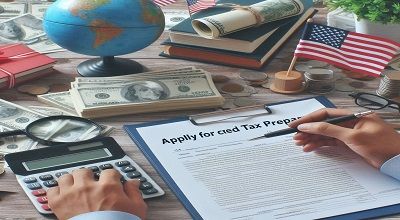Certified Tax Preparer
Applying to become a Certified Tax Preparer in the USA involves a few key steps, which generally include education, examination, obtaining a Preparer Tax Identification Number (PTIN), and meeting any state-specific requirements. The specific process can vary depending on the certification you are aiming for, as “Certified Tax Preparer” could refer to various certifications offered by different organizations, such as the IRS’s Annual Filing Season Program (AFSP) or credentials like the Enrolled Agent (EA), Certified Public Accountant (CPA), or certifications from the National Association of Tax Professionals (NATP) or the National Association of Enrolled Agents (NAEA).
Here’s a general outline to get you started:
1. Determine the Type of Certification
- Enrolled Agent (EA): This credential focuses solely on taxation and is the highest credential awarded by the IRS.
- Certified Public Accountant (CPA): Requires a more extensive education and allows for a broader range of accounting services beyond taxation.
- Annual Filing Season Program Participant: A voluntary IRS program that recognizes the efforts of non-credentialed tax return preparers who aspire to a higher level of professionalism.
2. Education Requirements
- EA: Pass the Special Enrollment Examination (SEE), which covers individual and business tax returns.
- CPA: Complete a bachelor’s degree in accounting or a related field, including a certain number of hours in accounting courses. Requirements vary by state.
- AFSP: Complete an annual IRS program consisting of continuing education courses.
3. Obtain a Preparer Tax Identification Number (PTIN)
All tax preparers need to obtain a PTIN from the IRS to legally prepare federal tax returns. The process is done online through the IRS website.
4. Examination
- EA Exam: Known as the Special Enrollment Exam (SEE), it consists of three parts covering various aspects of tax law.
- CPA Exam: A comprehensive exam that covers auditing and attestation, business environment and concepts, financial accounting and reporting, and regulation, including taxation. Administered by the American Institute of CPAs (AICPA).
5. Background Check and Application
Depending on the certification, you may need to undergo a background check. For EAs, this is part of the application process after passing the SEE.
6. Continuing Education
- EA: Requires 72 hours of continuing education every three years, with a minimum of 16 hours per year.
- CPA: Requirements vary by state but typically include continuing professional education (CPE) to maintain licensure.
- AFSP: Participants must complete annual continuing education requirements.
7. State-Specific Requirements
Some states may have additional requirements for tax preparers. Check with your state’s Board of Accountancy or Department of Taxation for details.
Steps to Apply
- Meet Educational Requirements: Complete any necessary educational prerequisites for your chosen certification.
- Get a PTIN: Apply for your Preparer Tax Identification Number through the IRS website.
- Pass the Required Examination(s): Study for and pass any required exams (e.g., SEE for EAs, CPA exam).
- Apply for Certification: Submit your application for certification, including passing exam scores, PTIN, and any other required documentation.
- Fulfill State Requirements: Ensure you meet any additional requirements or regulations set by your state.
Resources
- IRS Website: For PTIN registration, details about the EA exam, and the AFSP.
- AICPA Website: For information on the CPA examination and licensure requirements.
- State Boards of Accountancy: For state-specific CPA requirements.
- NAEA and NATP: For information on other certifications and continuing education opportunities,
Make sure to check the latest requirements and procedures on the relevant websites, as these can change. If you’re targeting a specific certification and need more detailed information, I can provide more targeted advice.
